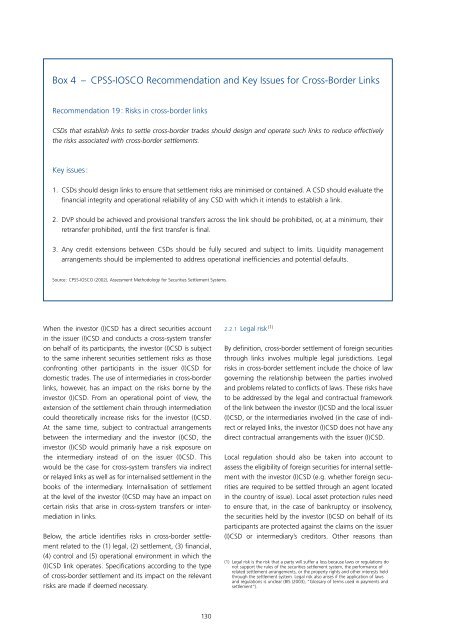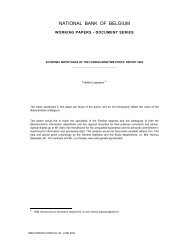Box 4 – CPSS-IOSCO Recommendation <strong>and</strong> Key Issues <strong>for</strong> <strong>Cross</strong>-Border LinksRecommendation 19 : Risks in cross-<strong>border</strong> linksCSDs that establish links to settle cross-<strong>border</strong> trades should design <strong>and</strong> operate such links to reduce effectivelythe <strong>risk</strong>s associated with cross-<strong>border</strong> <strong>settlement</strong>s.Key issues :1. CSDs should design links to ensure that <strong>settlement</strong> <strong>risk</strong>s are minimised or contained. A CSD should evaluate thefinancial integrity <strong>and</strong> operational reliability of any CSD with which it intends to establish a link.2. DVP should be achieved <strong>and</strong> provisional transfers across the link should be prohibited, or, at a minimum, theirretransfer prohibited, until the first transfer is final.3. Any credit extensions between CSDs should be fully secured <strong>and</strong> subject to limits. Liquidity managementarrangements should be implemented to address operational inefficiencies <strong>and</strong> potential defaults.Source : CPSS-IOSCO (2002), Assessment Methodology <strong>for</strong> Securities Settlement Systems.When the investor (I)CSD has a direct <strong>securities</strong> accountin the issuer (I)CSD <strong>and</strong> conducts a cross-system transferon behalf of its participants, the investor (I)CSD is subjectto the same inherent <strong>securities</strong> <strong>settlement</strong> <strong>risk</strong>s as thoseconfronting other participants in the issuer (I)CSD <strong>for</strong>domestic trades. The use of intermediaries in cross-<strong>border</strong>links, however, has an impact on the <strong>risk</strong>s borne by theinvestor (I)CSD. From an operational point of view, theextension of the <strong>settlement</strong> chain through intermediationcould theoretically increase <strong>risk</strong>s <strong>for</strong> the investor (I)CSD.At the same time, subject to contractual arrangementsbetween the intermediary <strong>and</strong> the investor (I)CSD, theinvestor (I)CSD would primarily have a <strong>risk</strong> exposure onthe intermediary instead of on the issuer (I)CSD. Thiswould be the case <strong>for</strong> cross-system transfers via indirector relayed links as well as <strong>for</strong> internalised <strong>settlement</strong> in thebooks of the intermediary. Internalisation of <strong>settlement</strong>at the level of the investor (I)CSD may have an impact oncertain <strong>risk</strong>s that arise in cross-system transfers or intermediationin links.Below, the article identifies <strong>risk</strong>s in cross-<strong>border</strong> <strong>settlement</strong>related to the (1) legal, (2) <strong>settlement</strong>, (3) financial,(4) control <strong>and</strong> (5) operational environment in which the(I)CSD link operates. Specifications according to the typeof cross-<strong>border</strong> <strong>settlement</strong> <strong>and</strong> its impact on the relevant<strong>risk</strong>s are made if deemed necessary.2.2.1 Legal <strong>risk</strong> (1)By definition, cross-<strong>border</strong> <strong>settlement</strong> of <strong>for</strong>eign <strong>securities</strong>through links involves multiple legal jurisdictions. Legal<strong>risk</strong>s in cross-<strong>border</strong> <strong>settlement</strong> include the choice of lawgoverning the relationship between the parties involved<strong>and</strong> problems related to conflicts of laws. These <strong>risk</strong>s haveto be addressed by the legal <strong>and</strong> contractual <strong>framework</strong>of the link between the investor (I)CSD <strong>and</strong> the local issuer(I)CSD, or the intermediaries involved (in the case of indirector relayed links, the investor (I)CSD does not have anydirect contractual arrangements with the issuer (I)CSD.Local regulation should also be taken into account toassess the eligibility of <strong>for</strong>eign <strong>securities</strong> <strong>for</strong> internal <strong>settlement</strong>with the investor (I)CSD (e.g. whether <strong>for</strong>eign <strong>securities</strong>are required to be settled through an agent locatedin the country of issue). Local asset protection rules needto ensure that, in the case of bankruptcy or insolvency,the <strong>securities</strong> held by the investor (I)CSD on behalf of itsparticipants are protected against the claims on the issuer(I)CSD or intermediary’s creditors. Other reasons than(1) Legal <strong>risk</strong> is the <strong>risk</strong> that a party will suffer a loss because laws or regulations donot support the rules of the <strong>securities</strong> <strong>settlement</strong> system, the per<strong>for</strong>mance ofrelated <strong>settlement</strong> arrangements, or the property rights <strong>and</strong> other interests heldthrough the <strong>settlement</strong> system. Legal <strong>risk</strong> also arises if the application of laws<strong>and</strong> regulations is unclear (BIS (2003), “Glossary of terms used in payments <strong>and</strong><strong>settlement</strong>“).130
CROSS-BORDER SECURITIES SETTLEMENT ANDRISK ANALYSIS FRAMEWORK FOR CROSS-BORDER LINKSbankruptcy or insolvency <strong>for</strong> blocking <strong>for</strong>eign <strong>securities</strong>(i.e. attachment by the issuer (I)CSD or intermediary’screditors, freeze or blocking instructions from local courtsor regulators) need to be assessed. Legal <strong>risk</strong> also includescustody <strong>risk</strong> which is defined as the <strong>risk</strong> of loss of <strong>securities</strong>held in custody occasioned by the insolvency, negligenceor fraudulent action of the custodian or of a subcustodian. Investor (I)CSDs typically use intermediaries incross-<strong>border</strong> links, who may again subdeposit <strong>securities</strong>with other intermediaries (i.e. typically the issuer (I)CSD).The involvement of multiple agents (i.e. tiering of holdings)has an impact on custody <strong>risk</strong>.At the level of the investor (I)CSD, the effectiveness ofclient recovery rules should also be assessed in the case ofbankruptcy or insolvency of the investor (I)CSD. Possiblelegal or practical uncertainties in the home jurisdictionmight have an impact on the speed with which <strong>for</strong>eignassets held through links are recovered by the liquidator.In the European context, some of the legislation relatingto <strong>securities</strong> <strong>settlement</strong> has been harmonised. TheSettlement Finality Directive, <strong>for</strong> example, aims at reducingthe systemic <strong>risk</strong> associated with participation in payment<strong>and</strong> <strong>securities</strong> <strong>settlement</strong> systems, <strong>and</strong> in particularthe <strong>risk</strong>s caused by the insolvency of a participant in thesesystems (1) . Settlement of a transaction is to be consideredirrevocable <strong>and</strong> unconditional in accordance withlocal market finality rules. If the investor (I)CSD receivesprovisional transfers of funds <strong>and</strong> <strong>securities</strong> via a crosssystem<strong>settlement</strong>, an unwinding of such transactionsdue to an insolvency or failure of a local participant in theissuer (I)CSD could create credit <strong>and</strong> liquidity problems <strong>for</strong>participants in the investor (I)CSD. Moreover, <strong>settlement</strong>could also be reversed due to existing claw-back rules inthe local market (2) .2.2.2 Settlement model<strong>Cross</strong>-system transfers with the issuer (I)CSD are executedin accordance with the applicable <strong>settlement</strong> model ofthe local issuer (I)CSD. The <strong>settlement</strong> cycle has an impacton replacement cost <strong>risk</strong> (or pre-<strong>settlement</strong> <strong>risk</strong>) which isthe <strong>risk</strong> that a counterparty to an outst<strong>and</strong>ing transaction<strong>for</strong> completion at a future date will fail to per<strong>for</strong>m on thecontract or agreement during the life of the transaction.The resulting exposure is the cost of replacing the originaltransaction at current market prices.When cross-system transfers are executed with a counterpartyin the issuer (I)CSD, the investor (I)CSD runs a<strong>settlement</strong> <strong>risk</strong> on that local counterparty. Settlement <strong>risk</strong>is a general term designating the <strong>risk</strong> that <strong>settlement</strong> ina transfer system will not take place as expected. Whenthe issuer (I)CSD has a DVP mechanism in place, principal<strong>risk</strong> <strong>for</strong> the investor (I)CSD will be eliminated, i.e. the<strong>risk</strong> that the seller of a security delivers a security butdoes not receive payment, or that the buyer of a securitymakes payment but does not receive delivery. The DVPmodel applied by the issuer (I)CSD will have an impact onreplacement cost <strong>risk</strong>, as well as on liquidity <strong>risk</strong> (i.e. the<strong>risk</strong> that a counterparty in a <strong>settlement</strong> system will notsettle an obligation on time). In gross <strong>settlement</strong> systems(DVP Model 1), replacement cost <strong>and</strong> liquidity <strong>risk</strong>s couldmaterialise throughout the batch / day on an operationby-operationbasis. In net systems (DVP Model 2 & 3),however, replacement cost <strong>and</strong> liquidity <strong>risk</strong>s are typicallybuilt up during the batch / day <strong>and</strong> could materialise on anet basis at the end of the batch / day.The <strong>settlement</strong> model is also defined by the cash <strong>settlement</strong>assets used, i.e. central or commercial bank money.As a rule, the investor (I)CSD will settle transactions in thelocal market through cash correspondents, as it has nodirect access to central bank liquidity or credit. By holdingcash balances with cash correspondents it bears cashdeposit <strong>risk</strong>.In the case of internalisation (i.e. at the level of the investor(I)CSD or intermediary), cross-<strong>border</strong> <strong>settlement</strong> isexecuted outside the local issuer (I)CSD <strong>and</strong> is there<strong>for</strong>esubject to other rules than those of the issuer (I)CSD. TheDVP <strong>settlement</strong> model, <strong>for</strong> example, applied in the investor(I)CSD might be different from the one in the issuer(I)CSD, whereas internalising <strong>settlement</strong> at the level ofintermediaries, such as local agents or global custodians,might make DVP rules less transparent. Moreover, <strong>for</strong>internal cross-<strong>border</strong> <strong>settlement</strong> at the level of the investor(I)CSD, <strong>securities</strong> <strong>and</strong> cash transfers are settled in onlyone system, as no <strong>settlement</strong> occurs in the books of theissuer (I)CSD or an intermediary. Consequently, <strong>settlement</strong>rules applicable in the local market do not have an impacton the <strong>settlement</strong> process in the books of the investor(I)CSD.2.2.3 Financial strengthBy making use of intermediaries in the case of indirect <strong>and</strong>relayed links, the investor (I)CSD has to check the solvency<strong>and</strong> financial resilience of its intermediary service provider.Since the issuer (I)CSD is part of the <strong>settlement</strong> chainingprocess, either active or passive depending on the typeof link <strong>and</strong> cross-<strong>border</strong> <strong>settlement</strong>, the <strong>analysis</strong> has to(1) The Settlement Finality Directive, adopted in May 1998, contains provisionsregarding (1) transfer orders <strong>and</strong> netting, (2) insolvenly proceedings <strong>and</strong>(3) collateral security.(2) Claw-back rules are provisions defining circumstances that lead to the reversalof transactions which occurred previously. Whenever claw-back rules exist,by definition, claw-back <strong>risk</strong> cannot be mitigated within the local jurisdiction.131
















